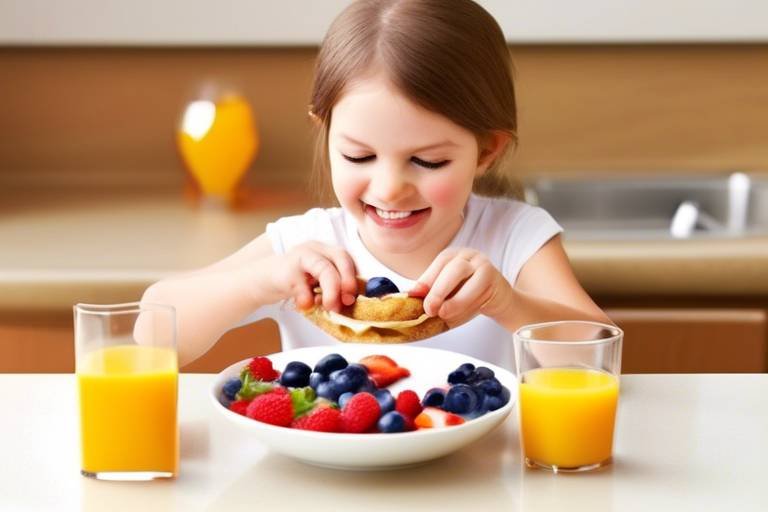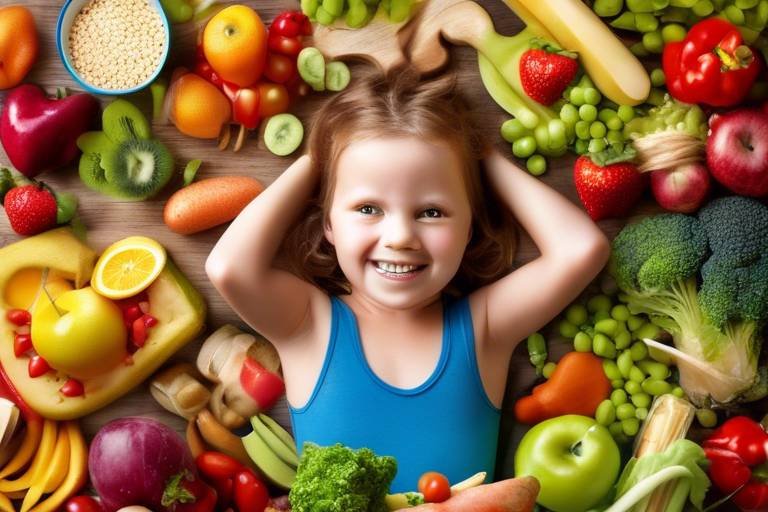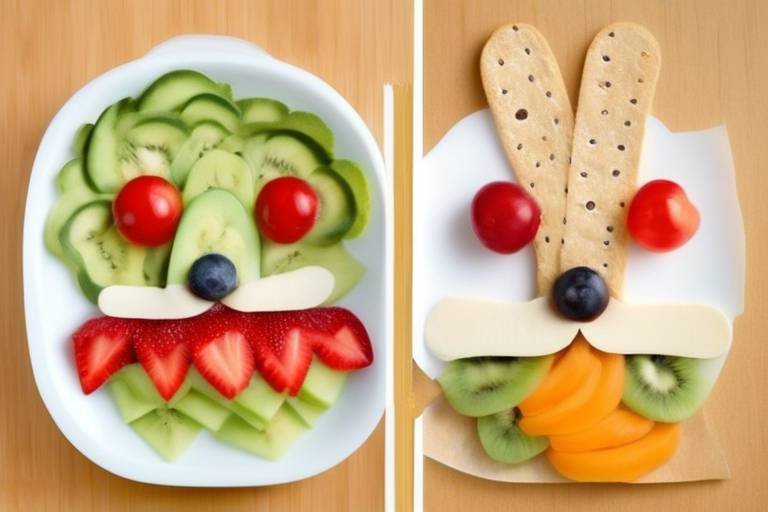Child Nutrition: Healthy Breakfast Ideas Your Kids Will Love
Every parent knows that getting kids to eat a healthy breakfast can sometimes feel like a battle. But what if I told you that breakfast could be both nutritious and exciting? That’s right! Starting the day with a healthy meal not only fuels their little bodies but also sets the tone for a productive day ahead. Breakfast is often referred to as the most important meal of the day, and for good reason. It provides the essential nutrients and energy that children need to learn, play, and grow. So, let’s dive into some creative and delicious breakfast ideas that your kids will absolutely love!
Understanding the significance of breakfast in a child's daily routine is crucial for parents. When kids skip breakfast, they miss out on vital nutrients that support their growth and development. Think of breakfast as the fuel that powers their brains and bodies. Studies show that children who eat a healthy breakfast perform better in school, are more alert, and have improved concentration. Not to mention, a nutritious breakfast can help stabilize their mood and energy levels, preventing those dreaded mid-morning slumps. So, let’s prioritize breakfast and make it a fun and enjoyable experience for our little ones!
Now that we understand why breakfast is essential, let’s explore some fantastic breakfast options that are not only healthy but also appealing to kids, even the picky eaters! The key is to make breakfast colorful, fun, and full of flavors. Here are some nutritious ideas that can easily be incorporated into your morning routine:
Incorporating fruits and vegetables into breakfast can provide a wealth of vitamins and minerals. Plus, they add a splash of color and flavor that can entice even the fussiest eaters. Think about it: a plate full of vibrant fruits can look like a rainbow, making it visually appealing for kids. Here are a couple of exciting options:
Smoothies are a fantastic way to blend fruits, vegetables, and dairy into a delicious concoction that kids can customize to their taste. Just toss some spinach, banana, and yogurt into a blender, and voilà! You’ve got a nutritious breakfast that’s fun to drink. Let your kids pick their favorite fruits and watch them get creative!
Omelets are another great way to sneak in those essential nutrients. By filling them with colorful vegetables like bell peppers, tomatoes, and spinach, you create a protein-rich breakfast that’s not only healthy but also delicious. Plus, kids can get involved in the preparation, making it more likely they’ll enjoy the meal. Encourage them to pick their favorite veggies and watch as they take pride in their culinary creation!
Whole grains are an excellent source of fiber and energy, making them an ideal base for a healthy breakfast. They keep kids full and satisfied throughout the morning, preventing those pesky hunger pangs before lunch. Here are some whole grain options to consider:
We all know mornings can be hectic, and sometimes, we need breakfast solutions that are quick and easy to prepare. Here are some simple breakfast recipes that can be made in under 15 minutes, ensuring your kids get the nutrition they need without the stress:
Overnight oats are a game-changer for busy mornings. Simply combine rolled oats, milk, and your choice of toppings like fruits, nuts, or honey in a jar the night before. By morning, you’ll have a delicious and healthy breakfast ready to grab and go. It’s a perfect way to introduce kids to the concept of meal prep!
Who doesn’t love pancakes? By using whole grain flour, you can whip up a batch of fluffy pancakes that are both tasty and nutritious. Top them with fresh fruits or a dollop of yogurt for added flavor and nutrients. It’s a breakfast that feels like a treat but is packed with goodness!
- Why is breakfast so important for my child's health? Breakfast provides essential nutrients and energy to kickstart your child's day, improving concentration and mood.
- How can I encourage my kids to eat a healthy breakfast? Make breakfast fun and colorful! Involve them in the preparation and let them choose their favorite fruits and toppings.
- What are some quick breakfast ideas for busy mornings? Overnight oats and whole grain pancakes are excellent options that can be prepared quickly and easily.

Importance of Breakfast for Kids
Breakfast is often dubbed the most important meal of the day, and for good reason—especially when it comes to our little ones. Imagine starting your day without fuel; it would be like trying to drive a car on empty! Kids need a solid breakfast to kickstart their metabolism and provide the energy they need for a busy day filled with learning and play. Not only does breakfast help to keep their energy levels up, but it also plays a crucial role in their overall growth and development.
Research has shown that children who eat breakfast tend to perform better academically. This is because breakfast provides essential nutrients that support brain function. Think of it as a power-up for their brains, helping them to focus and retain information better. Additionally, a nutritious breakfast can help stabilize blood sugar levels, which is vital for maintaining concentration throughout the morning. Without it, kids may feel sluggish, irritable, or even struggle to concentrate on their studies.
Moreover, breakfast is an excellent opportunity for parents to introduce a variety of foods and flavors into their children's diets. By serving a balanced meal that includes fruits, whole grains, and proteins, parents can ensure that their kids are receiving the vitamins and minerals they need to thrive. This not only helps in physical development but also instills healthy eating habits that can last a lifetime.
It’s essential to note that skipping breakfast can lead to unhealthy snacking later in the day. When kids are hungry, they are more likely to reach for sugary snacks or processed foods, which can contribute to poor dietary habits. This cycle can set the stage for long-term health issues, such as obesity and diabetes. Therefore, making breakfast a priority is not just about immediate energy; it's about laying the foundation for a healthy future.
In summary, breakfast is a vital part of a child's daily routine. It supports their physical and mental development, enhances academic performance, and encourages healthy eating patterns. So, the next time you're tempted to let your kids skip breakfast, remember that a well-rounded morning meal is a gift that keeps on giving throughout their day!

Nutritious Breakfast Options
When it comes to breakfast, the options are as diverse as the personalities of our little ones. It’s essential to find that not only fuel their bodies but also tantalize their taste buds. Kids can be notoriously picky eaters, but with a little creativity, you can whip up meals that are both healthy and appealing. Think of breakfast as the canvas where you can paint a masterpiece of flavors and nutrients, setting the tone for a productive day ahead.
One of the most exciting aspects of breakfast is the variety of ingredients you can incorporate. From colorful fruits to hearty whole grains, the possibilities are endless. For instance, you can create a colorful fruit salad that not only looks appealing but is also packed with vitamins and minerals. Imagine a bowl bursting with strawberries, blueberries, and bananas—a feast for the eyes and a boost for their health!
Another fantastic option is to include vegetables in your breakfast repertoire. Yes, you heard it right! Vegetables can be a delightful addition to morning meals. You can sneak in some spinach or bell peppers into an omelet or even blend them into a smoothie. This way, you’re not just serving breakfast; you’re serving a nutrient-rich start to their day. Kids often love to help in the kitchen, so why not get them involved? They may be more inclined to eat something they had a hand in making!
Whole grains are another cornerstone of a nutritious breakfast. They offer a hearty dose of fiber and energy, keeping kids full and focused until lunch. Consider whole grain toast topped with almond butter and banana slices or a bowl of oatmeal adorned with nuts and honey. These options are not only satisfying but also provide the essential nutrients that growing bodies need. Plus, they can be easily customized to suit your child’s preferences.
To sum it up, nutritious breakfast options don’t have to be boring or complicated. With a little imagination, you can create meals that are as exciting as they are healthy. Whether it’s a vibrant smoothie, a veggie-packed omelet, or a hearty bowl of oatmeal, there’s something for every palate. Remember, the goal is to make breakfast a fun and enjoyable experience that sets your kids up for a day full of energy and enthusiasm!
- What are some quick breakfast ideas for busy mornings? Overnight oats and smoothies are fantastic options that can be prepared in advance.
- How can I encourage my kids to eat healthier? Involve them in the cooking process and let them choose toppings or ingredients they like.
- Are there any breakfast options for kids with allergies? Absolutely! Many recipes can be modified to be gluten-free or dairy-free using alternative ingredients.

Fruits and Vegetables
Incorporating into your child's breakfast is not just a great way to add color to their plate; it's an essential step in providing them with the vitamins and minerals they need for healthy growth and development. Think of fruits and veggies as the superheroes of the breakfast world, ready to pack a punch of nutrition that can power your kids through their morning adventures. Imagine a plate filled with vibrant strawberries, crisp apples, and bright green spinach. It's not just visually appealing; it's a feast for the senses that can make breakfast exciting.
Research shows that children who consume a diet rich in fruits and vegetables are more likely to maintain a healthy weight, have better digestion, and even perform better in school. So, how can you make sure your little ones are getting enough of these nutritional powerhouses? One effective method is to blend them into smoothies or sneak them into omelets. For example, a green smoothie can be a delightful way to introduce kids to spinach or kale without them even knowing it. Just mix in some bananas and berries, and you've got a delicious treat that’s both nutritious and fun!
Another fantastic option is to create a colorful veggie omelet. Kids love to get involved in the kitchen, so why not let them choose their favorite vegetables? You can use a variety of ingredients such as:
- Bell peppers
- Cherry tomatoes
- Spinach
- Onions
By allowing them to help prepare their meals, you're not only making breakfast a fun activity but also encouraging them to eat healthy. Plus, when they see their hard work turn into a tasty meal, they’re more likely to dig in!
Fruits can also be a quick and easy addition to breakfasts. Think about topping a bowl of oatmeal or yogurt with fresh berries or sliced bananas. You can even make a fruit salad together on weekends, letting your kids choose their favorite fruits to mix in. This not only teaches them about healthy eating but also gives them a sense of ownership over their meals.
In conclusion, integrating a variety of fruits and vegetables into your child's breakfast can transform their morning routine into a colorful and nutritious experience. By turning breakfast into an engaging and interactive activity, you’re setting the stage for lifelong healthy eating habits. So, grab those fruits and veggies, and let the breakfast adventure begin!
Q1: How can I encourage my kids to eat more fruits and vegetables?
A1: Make it fun! Involve them in the preparation process, let them choose their favorite fruits and vegetables, and present the food in creative ways.
Q2: What are some quick ways to incorporate fruits and vegetables into breakfast?
A2: Smoothies, omelets, and topping oatmeal or yogurt with fruits are all quick and easy methods to add more nutrients to breakfast.
Q3: Are frozen fruits and vegetables just as nutritious as fresh ones?
A3: Yes! Frozen fruits and vegetables are often picked at peak ripeness and can be just as nutritious as fresh options. They’re also convenient and have a longer shelf life.

Smoothies
Smoothies are not just a trendy beverage; they are a fantastic way to sneak in nutrition while keeping breakfast fun and exciting for kids. Imagine starting your child’s day with a colorful, creamy drink that is packed with vitamins and minerals! The beauty of smoothies lies in their versatility. You can mix and match ingredients to suit your child's taste preferences, making it easier to ensure they get a balanced meal without any fuss.
To create a delicious smoothie that your kids will love, consider using a base of yogurt or milk, which adds a creamy texture and a dose of calcium. From there, you can throw in a variety of fruits—bananas, berries, or mangoes are popular choices. Want to add some greens? Spinach or kale can be easily hidden in the mix without altering the flavor too much. The result? A vibrant, nutrient-rich drink that looks as good as it tastes!
Here’s a simple recipe to get you started:
| Ingredients | Benefits |
|---|---|
| 1 banana | Rich in potassium and fiber |
| 1 cup of spinach | High in vitamins A, C, and K |
| 1/2 cup of yogurt | Good source of protein and probiotics |
| 1 cup of mixed berries | Loaded with antioxidants |
| 1 cup of milk (or a dairy-free alternative) | Provides calcium and vitamin D |
Simply blend these ingredients together until smooth, and voila! You have a breakfast that is not only delicious but also nourishing. Encourage your kids to participate in the blending process; they might be more inclined to drink something they helped create. Plus, smoothies can be served in fun cups with colorful straws, making them feel like a special treat rather than just another meal.
Another great aspect of smoothies is their portability. If your mornings are rushed, simply pour the smoothie into a to-go cup, and your kids can sip on their breakfast while you’re on the way to school or activities. This makes smoothies an ideal option for busy families who still want to prioritize nutrition.
So, next time you’re planning breakfast, consider reaching for the blender instead of the frying pan. With smoothies, you can turn a simple meal into a delightful experience that your kids will look forward to each morning!
1. Can I make smoothies ahead of time?
Absolutely! You can prepare smoothie packs by pre-measuring your ingredients and freezing them. In the morning, just blend with your liquid of choice!
2. How do I make a smoothie less sweet?
If you find your smoothies are too sweet, try reducing the amount of fruit or using unsweetened yogurt or milk alternatives.
3. What can I add to boost protein in smoothies?
Consider adding protein powder, nut butter, or seeds like chia or flaxseed for an extra protein punch.

Veggie Omelets
Veggie omelets are not just a breakfast option; they are a delightful canvas for creativity and nutrition! Imagine a fluffy, golden omelet filled with vibrant vegetables, each bite bursting with flavor and health benefits. This dish is a fantastic way to sneak in those essential vitamins and minerals that kids need to thrive. Plus, the best part? Kids can get involved in the cooking process! When children help prepare their meals, they are more likely to eat them, turning breakfast into a fun family activity.
To whip up a delicious veggie omelet, all you need are a few simple ingredients. Start with some eggs—nature's perfect protein source. Then, gather a colorful array of vegetables such as bell peppers, spinach, tomatoes, and mushrooms. You can even toss in some cheese for an extra layer of flavor. The beauty of omelets is their versatility; you can customize them to suit your child's taste preferences. If they love cheese, sprinkle in some shredded cheddar or mozzarella. If they’re adventurous, add in some spices like paprika or a dash of black pepper for a kick!
Here’s a quick recipe to get you started:
| Ingredients | Quantity |
|---|---|
| Eggs | 2 large |
| Bell pepper, diced | 1/4 cup |
| Spinach, chopped | 1/4 cup |
| Tomato, diced | 1/4 cup |
| Cheese (optional) | 1/4 cup |
| Salt and pepper | to taste |
To prepare the omelet, simply whisk the eggs in a bowl and season them with a pinch of salt and pepper. Heat a non-stick skillet over medium heat and pour in the eggs, tilting the pan to spread them evenly. As the eggs start to set, sprinkle your chosen veggies and cheese on one half of the omelet. Fold the other half over the filling and let it cook for another minute or two until the cheese melts and the veggies are tender. Voila! You have a delicious veggie omelet that’s not just nutritious but also visually appealing. Serve it with a side of whole-grain toast or fresh fruit to complete the meal.
Encouraging your kids to try veggie omelets can help them develop a taste for healthy foods. You might even find that they start asking for more vegetables in their meals! So, why not make breakfast a colorful, nutritious adventure? With veggie omelets, you can turn an ordinary morning into a delightful culinary experience that fuels your child's day.
1. Can I use egg substitutes for veggie omelets?
Yes, you can use egg substitutes or egg whites if you're looking for a lower-cholesterol option. Just make sure to adjust the cooking time as needed.
2. What vegetables work best in omelets?
Popular choices include bell peppers, spinach, mushrooms, onions, and tomatoes. Feel free to mix and match based on your child's preferences!
3. How can I make omelets more appealing to picky eaters?
Try using fun shapes with cookie cutters or serve the omelet with colorful sides like fruit or yogurt. Engaging kids in the cooking process can also spark their interest in trying new foods.
4. Can veggie omelets be made ahead of time?
Yes! You can prepare the filling ahead of time and store it in the fridge. When you're ready to eat, just whip up the eggs and add the prepped veggies for a quick breakfast.

Whole Grains
Whole grains are not just a trendy health buzzword; they are a powerhouse of nutrition that can significantly benefit your child's breakfast. Imagine starting the day with a bowl of hearty, whole grain goodness that keeps your little ones energized and satisfied. Whole grains contain all parts of the grain kernel—the bran, germ, and endosperm—ensuring that your kids get a full spectrum of nutrients. This makes them an excellent source of fiber, vitamins, and minerals, which are essential for growing bodies.
One of the best things about whole grains is their ability to keep kids feeling full longer. This means they are less likely to reach for unhealthy snacks before lunchtime. You might be wondering, "How can I incorporate more whole grains into my kids' breakfasts?" Well, here are some delicious options:
- Whole Grain Toast: Spread some nut butter or avocado on whole grain toast for a quick and nutritious start to the day.
- Brown Rice Pudding: Cooked brown rice mixed with milk, a touch of honey, and cinnamon can be a warm and comforting breakfast.
- Whole Grain Cereal: Look for cereals that list whole grains as the first ingredient and are low in sugar.
Whole grains not only provide energy but also support digestive health due to their high fiber content. Fiber helps maintain a healthy gut, which is crucial for overall well-being. Plus, whole grains can be incredibly versatile. You can use them in a variety of breakfast recipes, from pancakes to muffins, ensuring that your kids get the benefits without getting bored.
To make it even more exciting, you can involve your children in the kitchen. Let them help choose the whole grain products and participate in the cooking process. When kids are part of the meal preparation, they are more likely to try new foods and enjoy what they’ve made. So, next time you’re planning breakfast, consider adding whole grains to the menu. Your kids will not only love the taste but also reap the many health benefits!
1. What are whole grains?
Whole grains include the entire grain kernel, which consists of the bran, germ, and endosperm. Examples include oats, brown rice, quinoa, and whole wheat.
2. Why are whole grains important for kids?
Whole grains provide essential nutrients, including fiber, vitamins, and minerals, which are crucial for growth, energy, and overall health.
3. How can I introduce whole grains to my child's diet?
Start by substituting refined grains with whole grains in your meals. For example, use whole grain bread instead of white bread or serve whole grain pasta.
4. Are whole grain cereals healthy?
Yes, whole grain cereals can be a healthy option, especially if they are low in sugar and high in fiber. Always check the ingredient list to ensure whole grains are the first ingredient.
5. Can I make whole grain pancakes?
Absolutely! You can easily make whole grain pancakes using whole wheat flour or oats. Top them with fruits or yogurt for a nutritious breakfast.

Quick and Easy Recipes
In today's fast-paced world, mornings can often feel like a whirlwind. Between getting the kids ready for school and preparing for your own day, it can be challenging to whip up a nutritious breakfast. But fear not! With a little creativity and some quick recipes, you can ensure your children start their day with a healthy meal that they’ll actually enjoy. Let’s dive into some quick and easy breakfast recipes that are not only delicious but also packed with essential nutrients.
One of the best things about quick breakfast recipes is their versatility. You can easily customize them based on your kids' preferences, making breakfast a fun and interactive experience. For instance, overnight oats are a fantastic option that requires minimal preparation. Simply combine rolled oats with milk or yogurt, add a touch of honey or maple syrup, and toss in some fruits and nuts. Let it sit in the fridge overnight, and in the morning, you have a ready-to-eat breakfast that’s both satisfying and nutritious. Kids can even help choose their favorite toppings, turning breakfast into a personalized creation!
Another crowd-pleaser is whole grain pancakes. These fluffy delights can be made in a jiffy and are a great way to sneak in some whole grains. You can mix whole wheat flour with baking powder, a pinch of salt, and milk to create a batter that’s quick to whip up. For a fun twist, try adding mashed bananas or blueberries directly into the batter. Serve them with a drizzle of honey or a dollop of yogurt, and watch your kids devour them with glee!
Let’s not forget about smoothies, which are like a breakfast in a glass! They are incredibly easy to prepare and can be a great way to sneak in fruits and veggies. Simply blend together some spinach, a banana, and a cup of yogurt or milk. If your kids love a bit of sweetness, throw in some berries or a spoonful of peanut butter. The best part? They can customize their smoothies with different ingredients, making it a fun morning ritual.
Here’s a quick table summarizing these quick and easy recipes:
| Recipe | Preparation Time | Key Ingredients |
|---|---|---|
| Overnight Oats | 5 mins (prep the night before) | Rolled oats, milk/yogurt, fruits, nuts |
| Whole Grain Pancakes | 10 mins | Whole wheat flour, baking powder, milk, fruits |
| Fruit Smoothies | 5 mins | Fruits, yogurt/milk, optional greens |
These recipes not only save time but also ensure your kids are getting the nutrients they need to power through their day. Plus, involving them in the preparation can make them more excited about eating breakfast. So, next time you’re in a rush, remember that a healthy breakfast doesn’t have to be complicated. Just a few simple ingredients and a little creativity can go a long way!
1. How can I make breakfast more appealing to my kids?
Consider involving your kids in the preparation process. Let them choose their favorite toppings or help with mixing ingredients. Making breakfast colorful with fruits and fun shapes can also entice them to eat.
2. What are some quick alternatives to sugary cereals?
Try whole grain options like oatmeal, overnight oats, or whole grain toast with nut butter. These options provide more fiber and nutrients than sugary cereals.
3. Can I prepare breakfast the night before?
Absolutely! Overnight oats and pre-made smoothie packs are great options. You can also prepare pancake batter the night before and store it in the fridge for a quick morning cook-up.
4. How can I incorporate vegetables into breakfast?
Veggie omelets, smoothies with spinach or kale, and adding grated vegetables to pancakes or muffins are excellent ways to sneak in some greens.

Overnight Oats
Overnight oats are not just a trend; they are a game-changer for busy families looking to provide their kids with a nutritious breakfast without the morning rush. Imagine waking up to a delicious meal that’s already prepared and waiting for you in the fridge! This simple yet effective breakfast option allows you to mix various ingredients the night before, making mornings a breeze. All you need is a jar, some oats, and your choice of liquid, and you're set!
To prepare overnight oats, start with rolled oats as your base. They are packed with fiber and will keep your child full until lunchtime. Combine them with milk, yogurt, or a dairy-free alternative, and let the magic happen overnight in the fridge. The oats absorb the liquid, soften, and become a creamy delight by morning. You can even sneak in some healthy extras like chia seeds for added omega-3 fatty acids or protein powder for that extra boost!
One of the best parts about overnight oats is their versatility. You can customize them to suit your child's taste preferences. Here are a few delicious combinations to consider:
- Berry Blast: Mix oats with almond milk, and top with strawberries, blueberries, and a drizzle of honey.
- Banana Nut: Combine oats with yogurt, sliced bananas, and a sprinkle of walnuts or almonds for that crunchy texture.
- Chocolate Delight: Stir in cocoa powder or chocolate protein powder, and top with banana slices and a dollop of peanut butter.
Not only are these combinations tasty, but they also provide essential nutrients that help fuel your child's day. You can even involve your kids in the preparation process. Let them choose their favorite toppings or mix-ins, making breakfast a fun and engaging activity. Plus, when they have a hand in creating their meal, they are more likely to enjoy eating it!
For those who love some crunch, consider adding toppings right before serving. A sprinkle of granola, a handful of nuts, or a few seeds can elevate the dish and add that satisfying crunch. Just remember to store the oats in an airtight container to keep them fresh and delicious!
In conclusion, overnight oats are not just a nutritious option; they're a creative way to make breakfast exciting for kids. With minimal prep time and endless flavor possibilities, you can ensure your children start their day with a meal that’s both enjoyable and beneficial for their growth and development.
1. Can I prepare overnight oats for multiple days?
Absolutely! Overnight oats can be prepared in batches and stored in the refrigerator for up to five days. Just make sure to keep the toppings separate until you're ready to eat them to maintain their freshness.
2. What type of oats should I use?
Rolled oats are the best choice for overnight oats as they absorb liquid well and create a creamy texture. Avoid instant oats, as they can become mushy.
3. Can I use non-dairy milk?
Yes! Non-dairy options like almond milk, oat milk, or coconut milk work perfectly in overnight oats. They add flavor and are great alternatives for those with lactose intolerance.
4. How can I make overnight oats more filling?
To make overnight oats more filling, add protein-rich ingredients like Greek yogurt, nut butter, or seeds. These additions will help keep your child satisfied until their next meal.
5. Are overnight oats healthy?
Definitely! Overnight oats are packed with nutrients, including fiber, vitamins, and minerals. They provide a balanced breakfast that can help sustain energy levels throughout the morning.

Whole Grain Pancakes
When it comes to breakfast, pancakes are a classic favorite among kids, and why not? They’re fluffy, versatile, and oh-so-delicious! But what if you could elevate this beloved dish into something that not only tantalizes their taste buds but also packs a nutritional punch? Enter ! These pancakes are a fantastic way to incorporate more fiber and whole grains into your child’s diet, ensuring they start their day with sustained energy.
Making whole grain pancakes is surprisingly easy and can be done in a flash. With just a few simple ingredients, you can whip up a batch that your kids will adore. Imagine the excitement on their faces when they see a stack of golden-brown pancakes topped with fresh fruits or a dollop of yogurt! Not only do these toppings add flavor, but they also increase the nutritional value of the meal. You can use a variety of fruits like bananas, berries, or even apples to create a colorful and appealing breakfast.
Here's a quick overview of why whole grain pancakes are a great choice:
- High in Fiber: Whole grains provide more fiber than refined grains, which helps keep kids full and satisfied longer.
- Better Nutritional Profile: Whole grains retain more nutrients, including B vitamins and antioxidants, which are essential for growing bodies.
- Versatile Ingredients: You can easily customize the recipe by adding ingredients like nuts, seeds, or even a scoop of protein powder for an extra boost.
Now, let’s talk about preparation. You can make whole grain pancakes from scratch using whole wheat flour, or you can opt for a pre-made whole grain pancake mix for convenience. If you choose to make them from scratch, here’s a simple recipe to get you started:
Ingredients: - 1 cup whole wheat flour - 1 tablespoon baking powder - 1 tablespoon sugar (optional) - 1/4 teaspoon salt - 1 cup milk (or a dairy-free alternative) - 1 large egg - 2 tablespoons melted butter or oil
Mix the dry ingredients in one bowl and the wet ingredients in another, then combine them. Cook on a preheated skillet until bubbles form on the surface, then flip! In less than 15 minutes, you’ll have a stack of fluffy, nutritious pancakes ready to go.
One of the best parts about whole grain pancakes is that they can easily be made ahead of time. You can double the recipe and freeze the extras, so on those busy mornings, all you need to do is pop them in the toaster or microwave. This way, you can ensure your kids have a healthy breakfast without spending too much time in the kitchen.
So, the next time you’re pondering what to whip up for breakfast, consider whole grain pancakes. They’re not just a meal; they’re a canvas for creativity! Let your kids help with the toppings, and watch as they transform their pancakes into colorful works of art. Not only will they enjoy eating them, but they’ll also feel empowered by participating in the cooking process.
1. Can I use regular pancake mix to make whole grain pancakes?
Yes, you can use a regular pancake mix and simply look for one that is labeled as whole grain. Many brands offer whole grain options that are just as tasty!
2. How can I make pancakes healthier?
You can make pancakes healthier by using whole grain flour, adding fruits or nuts, reducing sugar, and using healthier fats like olive oil or coconut oil.
3. Can I make pancakes ahead of time?
Absolutely! You can prepare the batter the night before or cook the pancakes and freeze them for later. Just reheat them in the toaster or microwave when you're ready to eat.
4. What are some good toppings for whole grain pancakes?
Some great toppings include fresh fruits, yogurt, nut butter, honey, or even a sprinkle of cinnamon for added flavor!
Frequently Asked Questions
- Why is breakfast so important for kids?
Breakfast kickstarts your child's metabolism and provides essential nutrients that fuel their brain and body for the day ahead. It helps improve concentration, enhances mood, and can lead to better academic performance. Think of it as putting gas in a car; without it, they just won't run as smoothly!
- What are some quick and healthy breakfast ideas?
If you're short on time, consider options like overnight oats, which you can prepare the night before, or whole grain pancakes that can be whipped up in a flash. Smoothies are also a fantastic choice; just blend some fruits, veggies, and yogurt for a nutritious drink that kids will love!
- How can I get my picky eater to enjoy breakfast?
Getting a picky eater to enjoy breakfast can be a challenge! Try involving them in the preparation process; kids are often more excited to eat something they've helped make. You can also make breakfast fun by creating colorful plates with fruits and veggies or letting them customize their own smoothies!
- Are there any breakfast foods I should avoid?
Yes, it's best to steer clear of sugary cereals, pastries, and processed breakfast foods that are high in sugar and low in nutrients. These can lead to energy crashes and don't provide the lasting fuel your child needs. Instead, focus on whole foods that offer vitamins and minerals.
- Can breakfast help with my child's growth and development?
Absolutely! A balanced breakfast containing proteins, healthy fats, and whole grains supports your child's growth and development. It provides the necessary energy for their daily activities and helps maintain their focus and energy levels throughout the day.
- What are some ways to incorporate more fruits and vegetables into breakfast?
Incorporating fruits and veggies can be as simple as adding banana slices to oatmeal or spinach to an omelet. You can also make smoothies with a mix of fruits and hidden veggies like kale or spinach, ensuring your kids get a nutrient boost without even realizing it!



















